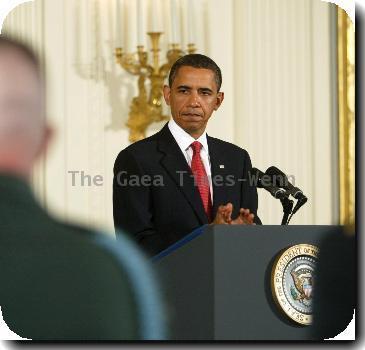Interior Secretary Ken Salazar says effort to stop oil leak hits snag, but work continues
By APSaturday, May 15, 2010
Salazar: Latest effort to stop oil leak hits snag
HAMMOND, La. — At first, BP tried to stop the oil rushing into the Gulf of Mexico by flipping a blowout preventer switch. A week ago, they attempted to capture the leak with a 100-ton box. Now they’ve hit a snag as they try to guide a mile-long tube into the gusher to siphon the oil.
Interior Secretary Ken Salazar said BP PLC had a problem Saturday with the latest effort to stop the leak, but was continuing its work at the ocean floor.
“There was a problem. They had to reconfigure. They are back down again … trying to get it inserted,” he told reporters during a briefing at a bird rescue facility in Louisiana, declining to offer further information.
BP has offered scant details of its progress in trying to thread the 6-inch tube into the 21-inch pipe spewing oil from the ocean floor. Company spokesmen said technicians are continuing the methodical work that began early Friday of using joysticks to guide the deep-sea robots that are manipulating the contraption. They wouldn’t elaborate on Salazar’s report.
“We’ve never done such operations before and we need to take our time to get it right,” spokesman Jon Pack said in an e-mail Saturday after Salazar’s comments.
The company planned to brief reporters on the tube work in the afternoon. The tube is intended to suck oil up like a straw to a tanker on the surface, while a stopper surrounding it would keep crude from leaking into the sea.
Other efforts to fight the spill continued above and below the surface. The company received word Friday that federal regulators had approved spraying chemical dispersants beneath the sea, a contentious development because it has never been done underwater.
More than three weeks after the oil rig explosion that killed 11 workers and set off the disastrous spill, President Barack Obama assailed oil drillers and his own administration Friday as he ordered extra scrutiny of drilling permits. He condemned a “ridiculous spectacle” of oil executives shifting blame in congressional hearings and denounced a “cozy relationship” between the companies and the federal government.
“I will not tolerate more finger-pointing or irresponsibility,” Obama said in the White House Rose Garden, flanked by members of his Cabinet.
“The system failed, and it failed badly. And for that, there is enough responsibility to go around. And all parties should be willing to accept it,” the president said.
But the president, who had earlier announced a limited expansion of offshore drilling that’s now on hold, didn’t back down from his support for domestic oil drilling.
Obama’s tone was a marked departure from the deliberate approach and mild chiding that had characterized his response since the rig went up in flames April 20 and sank two days later. At least 210,000 gallons of oil has been leaking into the Gulf each day, and BP has sought to burn the crude off the surface of the water, as well as use the chemical dispersants.
U.S. Coast Guard Rear Adm. Mary Landry said Friday that three underwater dispersant tests conducted at the leak site proved helpful at keeping oil from reaching the surface. Traditionally used on the surface, chemical dispersants act like a detergent to break the oil into small globules, which allows it to disperse more quickly into the water or air before currents can wash it ashore.
So far more than 517,000 gallons of dispersants, most of which is a product called Corexit 9500 previously approved by the Environmental Protection Agency for use on the sea surface only, have been dropped over the spill or shot undersea.
Corexit 9500 is identified as a “moderate” human health hazard that can cause eye, skin or respiratory irritation with prolonged exposure, according to safety data documents. Louisiana Health and Hospitals Secretary Alan Levine said federal regulators dismissed state worries about the chemicals.
“Our concerns about the use of these dispersants underwater is based on the fact that there is virtually no science that supports the use of those chemicals,” Levine said.
EPA Administrator Lisa Jackson has said she reserves the right to halt the use of chemical dispersants at any time if new data show more serious environmental harm is occurring.
The Obama administration insists its response has been aggressive ever since the spill started, and the president said he shared the anger and frustration of those affected. He announced that the Interior Department would review whether the Minerals Management Service is following all environmental laws before issuing permits for offshore oil and gas development.
BP’s drilling operation at Deepwater Horizon received a “categorical exclusion,” which allows for expedited oil and gas drilling without the detailed environmental review that normally is required.
Obama already had announced a 30-day review of safety procedures on oil rigs and at wells before any additional oil leases could be granted. And earlier in the week Salazar announced plans to split the much-criticized Minerals Management Service into two agencies, one that would be charged with inspecting oil rigs, investigating oil companies and enforcing safety regulations, while the other would oversee leases for drilling and collection of billions of dollars in royalties. Salazar has said the plan will ensure there is no conflict, “real or perceived,” regarding the agency’s functions.
Associated Press writers Janet McConnaughey near Fort Jackson, Erica Werner, Matthew Daly and Frederic J. Frommer in Washington, Jason Dearen in New Orleans and Melinda Deslatte in Baton Rouge, La., contributed to this report.
Tags: Accidents, Barack Obama, Energy, Environmental Concerns, Fort Jackson, Government Regulations, Hammond, Industry Regulation, Louisiana, North America, Oceans, Products And Services, United States

